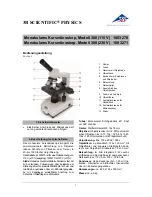
7
STEINDORFF
®
5.
Orthogonal polarized observation:
Because the polarizer is located in the light path, this time is single polarized light state after
focusing. Slide the analyzer into the light path, to adjust the analyzer adjusting rob on the
“0”position, also the polarizer is located on the“0”position, this time is orthogonal polarized light
state (polarized direction of the polarizer is at west-east, polarized direction of the analyzer is at
north-south).
When using 10×objective or lower. Please remove compensation lens, and adjust condenser to
proper place; when using 20 × objectives or higher, please push compensation lens to the previous
position and lift the condenser to the highest position.
Insert gypsum (λ), mica (1/4λ) sample, quartz wedge into complementary inlet according to your
need in order to test pixel.
6.
Observation of cone light:
Observation of cone light is use 20× or higher objectives, push the Bertrand lens and
compensation lens into the light path, adjusting center of the Bertrand lens, to observe the cone
light characteristic of the sample.
VII.
MAINTENANCE:
1.
If there is any dirt settled on the lens, wipe it off gently with some lens paper. If alcohol is used, be
careful not to let it penetrate through the lenses and dissolve the gumming. Any dust settled on the
lenses can be blown away with an air blower or wiped off with a clean soft camel hair brush.
2.
In cleaning mechanical parts and applying non-corrosive lubricant, take special care not to touch
the optical elements, especially the objective lenses.
3.
Avoid high temperature.
4.
Put objectives and eyepieces into box after using, and keep them in a cool, shady and dry place,
free from dust, fumes and moisture. If not stored in its box, cover with a hood to protect from
dust.
5.
Like other optical instruments, the microscope should be kept out of direct sunlight in a cool, dry
place, free from dust, fumes and moisture. It should be stored in a case or covered with a hood to
protect it from dust.
6.
The microscope has been carefully tested and inspected.























